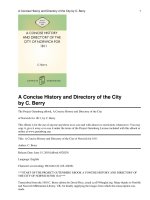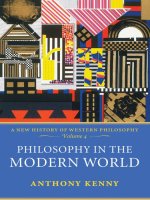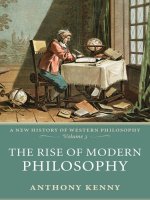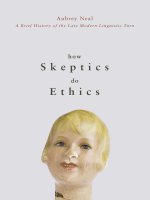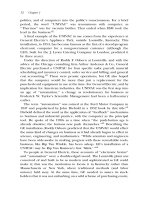A concise history of modern india
Bạn đang xem bản rút gọn của tài liệu. Xem và tải ngay bản đầy đủ của tài liệu tại đây (3.98 MB, 491 trang )
Tai Lieu Chat Luong
AConciseHistoryofRussia
Accessible to students, tourists, and general readers alike, this book
provides a broad overview of Russian history since the ninth century.
Paul Bushkovitch emphasizes the enormous changes in the
understanding of Russian history resulting from the end of the Soviet
Unionin1991.Sincethen,newmaterialhascometolightonthehistory
of the Soviet era, providing new conceptions of Russia’s prerevolutionary past. The book traces not only the political history of
Russia, but also developments in its literature, art, and science.
Bushkovitch describes well-known cultural figures, such as Chekhov,
Tolstoy, and Mendeleev in their institutional and historical contexts.
Though the 1917 revolution, the resulting Soviet system, and the Cold
War were a crucial part of Russian and world history, Bushkovitch
presents earlier developments as more than just a prelude to Bolshevik
power.
Paul Bushkovitch is a professor of history at Yale University, where he
hastaughtforthepast36years.HeistheauthorofPetertheGreat:The
StruggleforPower,1671–1725(Cambridge2001);ReligionandSociety
in Russia: The Sixteenth and Seventeenth Centuries (1991); and The
Merchants of Moscow, 1580–1650 (Cambridge 1980). His articles have
appearedinSlavicReview,RussianReview,JahrbücherfürGeschichte
Osteruopas, and Kritika. He is a member of the editorial board for the
CahiersduMondeRusse.
“ForanystudenttryingtogetagraspoftheessentialsofRussianhistory
thisbookistheplacetostart.Tocovereverythingfromtheoriginsofthe
Russian people to the collapse of the Soviet Union in one short book
requiresgreatskill,butPaulBushkovitchisoneoftheleadingexpertson
Russianhistoryintheworldandhemanagesthistaskwithgreatinsight
andpanache.”
–DominicLieven,TrinityCollege,CambridgeUniversity
“This is a lively and readable account, covering more than a thousand
years of Russian history in an authoritative narrative. The author deals
perceptively not only with political developments, but also with those
aspects of modern Russian culture and science that have had an
internationalimpact.”
–MaureenPerrie,UniversityofBirmingham
“IfyouwanttounderstandRussia,andthestoryoftheRussians,youcan
do no better than Paul Bushkovitch’s A Concise History of Russia.
Bushkovitch has performed a minor miracle: he’s told the remarkably
complicated,convoluted,andcontroversialtaleofRussianhistorysimply,
directly, and even-handedly. He doesn’t get mired in the details, lost in
the twists and turns, or sidetracked by axe grinding. He tells you what
happenedandwhy,fullstop.Soifyouwanttoknowwhathappenedand
why in Russian history, you’d be advised to begin with Bushkovitch’s
masterfulintroduction.”
–MarshallPoe,UniversityofIowa
“Both learned and accessible, this short history of Russia’s troubled
passagetothepresenttellsastoryofastateandapeoplewhocreated
an empire that much of the world saw as a threat. Whether as the
‘Gendarme of Europe’ or the ‘Red Menace,’ Russia and its Soviet
successor (even Putin’s Russia today!) have been as much
misunderstoodastheyhavebeenfeared.PaulBushkovitchbringsusa
sober reading of Russia’s difficult rises and falls, expansions and
contractions,reformsandrevolutions.Ratherthanseeingthepreceding
millennium as a prelude to the seventy years of the Soviet Union, he
givesusaroundedportraitofacountryhobbledandhumbledbyitsown
geography,institutionslikeautocracyandserfdom,andgrandioseplans
to create utopia. Judicious in its judgments, this gracefully written work
ranges from high politics to music and literature to open a window
through which a reader might begin or renew an acquaintance with the
enigmasthatwereRussia.”
–RonaldGrigorSuny,UniversityofMichigan
CambridgeConciseHistories
Thisisanewseriesofillustrated“concisehistories”ofselectedindividual
countries, intended both as university and college textbooks and as
general historical introductions for general readers, travelers, and
membersofthebusinesscommunity.
Othertitlesintheseries:
AConciseHistoryofAustralia,3rdEditionStuartMacintyre
AConciseHistoryofAustriaStevenBeller
AConciseHistoryofBolivia,2ndEditionHerbertS.Klein
A Concise History of Brazil Boris Fausto, translated by Arthur
Brakel
AConciseHistoryofBritain,1707–1975W.A.Speck
AConciseHistoryofBulgaria,2ndEditionR.J.Crampton
AConciseHistoryoftheCaribbeanB.W.Higman
AConciseHistoryofFinlandDavidKirby
AConciseHistoryofFrance,2ndEditionRogerPrice
AConciseHistoryofGermany,2ndEditionMaryFulbrook
AConciseHistoryofGreece,2ndEditionRichardClogg
A Concise History of Hungary Miklós Molnár, translated by anna
magyar
AConciseHistoryofModernIndia,2ndEditionBarbaraD.Metcalf
andThomasR.Metcalf
AConciseHistoryofItalyChristopherDuggan
AConciseHistoryofMexico,2ndEditionBrianR.Hamnett
AConciseHistoryofNewZealandPhilippaMeinSmith
A Concise History of Poland, 2nd Edition Jerzy Lukowski and
HubertZawadzki
AConciseHistoryofPortugal,2ndEditionDavidBirmingham
AConciseHistoryofSouthAfrica,2ndEditionRobertRoss
AConciseHistoryofSpainWilliamD.PhillipsJr.andCarlaRahn
Phillips
AConciseHistoryofSwedenNeilKent
AConciseHistoryofWalesGeraintH.Jenkins
AConciseHistoryofRussia
PaulBushkovitch
YaleUniversity
CAMBRIDGEUNIVERSITYPRESS
Cambridge, New York, Melbourne, Madrid, Cape Town, Singapore, São
Paulo,Delhi,Tokyo,MexicoCity
CambridgeUniversityPress
32AvenueoftheAmericas,NewYork,NY10013-2473,USA
www.cambridge.org
Informationonthistitle:www.cambridge.org/9780521543231
©PaulBushkovitch2012
Thispublicationisincopyright.Subjecttostatutoryexceptionandtothe
provisionsofrelevantcollectivelicensingagreements,noreproductionof
any part may take place without the written permission of Cambridge
UniversityPress.
Firstpublished2012
PrintedintheUnitedStatesofAmerica
AcatalogrecordforthispublicationisavailablefromtheBritishLibrary.
LibraryofCongressCataloginginPublicationdata
Bushkovitch,Paul.
AconcisehistoryofRussia/PaulBushkovitch.
p.cm.–(Cambridgeconcisehistories)
Includesbibliographicalreferencesandindex.
ISBN 978-0-521-83562-6 (hardback : alk. paper) – ISBN 978-052154323-1(pbk.:alk.paper)
1. Russia – History. 2. Soviet Union – History. 3. Russia (Federation) –
History.I.Title.
DK37.B862011
947–dc232011026272
ISBN978-0-521-83562-6Hardback
ISBN978-0-52154323-1Paperback
Cambridge University Press has no responsibility for the persistence or
accuracyofURLsforexternalorthird-partyInternetWebsitesreferredto
inthispublicationanddoesnotguaranteethatanycontentonsuchWeb
sitesis,orwillremain,accurateorappropriate.
Contents
ListofFigures
Abbreviations
Acknowledgments
Prologue
1.Russiabeforerussia
2.Moscow,novgorod,lithuania,andthemongols
3.Theemergenceofrussia
4.Consolidationandrevolt
5.Peterthegreat
6.Twoempresses
7.Catherinethegreat
8.Russiaintheageofrevolution
9.Thepinnacleofautocracy
10.Cultureandautocracy
11.Theeraofthegreatreforms
12.Fromserfdomtonascentcapitalism
13.Thegoldenageofrussianculture
14.Russiaasanempire
15.Autocracyindecline
16.Warandrevolution
17.Compromiseandpreparation
18.Revolutionsinrussianculture
19.Buildingutopia
20.War
21.Growth,consolidation,andstagnation
22.Sovietculture
23.Thecoldwar
Epilogue:TheEndoftheUSSR
FurtherReading
Index
ListofFigures
1.VladimirCathedraloftheDormition(TwelfthCentury)
2.BirchbarkDocument210
3.KirillovMonastery(15–16centuries)
4.“Kremlenagrad”
5.PetertheGreat
6.Bashkirs
7.CatherinetheGreat
8.St.Petersburgc.1800
9.VillageCouncil
10.AlexanderII
11.RussianPeasantGirls
12.IlyaMuromets
13.Tchaikovsky
14.Repin/Tolstoy
15.NomadicKirghiz
16.Witte
17.NicholasII
18.LeninandColleagues
19.StalinandOthersatGorky’sfuneral
20.IlyushinII
Abbreviations
BRBML
BeineckeRareBookandManuscriptLibrary
LOC
LibraryofCongress
LOCPG
LibraryofCongress,Prokudin-GorskyCollection
NASM
SmithsonianNationalAirandSpaceMuseum
NYPL
NewYorkPublicLibrary
YCBA
YaleCenterforBritishArt
Acknowledgments
ThefirstchaptersofthisbookwerewrittenattheUniversityofAberdeen,
Scotland, during a semester of residence with the support of the
Carnegie Trust for the Universities of Scotland. Without the Carnegie
Trust and Aberdeen University the beginning would have been much
moredifficult.IoweaparticulardebtofgratitudetoPaulDukes,Robert
Frost,KarinFriedrich,JaneOhlmeyer,andDuncanRice,intheirdifferent
waysmyhostsforaneventfultime.Overtheyearsmycolleagueshave
kindly read and commented on many of the chapters, letting me know
whenIwasontherighttrackandwhenIwasnot.Forreadingaswellas
discussion and bibliographical help, I thank Nikolaos Chrissidis, Laura
Engelstein, Hilary Fink, Daniel Kevles, John MacKay, Edgar Melton,
Bruce Menning, and Samuel Ramer. Many years of conversation about
RussianculturewithVladimirAlexandrov,KaterinaClark,NikolaiFirtich,
HarveyGoldblatt,VladimirGolshtein,AndreaGraziosi,CharlesHalperin,
MosheLewin,AlexanderSchenker,andElizabethValkeniermademany
chapters much richer than I could have made them alone. Valerie
HansenandFrankTurnerprovidedmorehelpthantheyeverrealized.As
ever,TatjanaLorkovicwasinvaluable.
I would also like to thank Tom Morehouse of the New England Air
Museum,KateIgoeoftheSmithsonianNationalAirandSpaceMuseum,
MariaZapataoftheHaasArtLibraryofYaleUniversity,DavidThompson
and Maria Singer of the Yale Center for British Art, and Kathryn James
andE.C.SchroederoftheBeineckeRareBookandManuscriptLibrary
ofYaleUniversity.Theircourtesyandprofessionalismwereinvaluablein
thesearchforsuitableimages.
Maija Jansson suffered through the long gestation and birth pains of
thebook,puttingupwithadistractedandoftencrabbyauthor.Sheread
the whole manuscript, some of it several times, and kept reminding me
thatitwouldcometoanend,andsoitdid.ToherIdedicatetheresult.
Prologue
Russia is not an idea. It is a specific country, with a particular place on
theglobe,amajoritylanguageandculture,andaveryconcretehistory.
Yet for most of the twentieth century, outside of its boundaries, it has
been an idea, not a place – an idea about socialism. Tremendous
debates have raged over its politics, economics, and culture, most of
themconductedbyandforpeoplewhodidnotknowthelanguage,never
went there, and knew very little about the country and its history. Even
thebetterinformedwroteandspokestartingfrompresuppositionsabout
the desirability or undesirability of a socialist order. Some were crude
propagandists,buteventhemoreconscientious,thosewholearnedthe
languageandtriedtounderstandthecountry,beganbyposingquestions
that came from their assumptions about socialism. The result was a
narrowagendaofdebate:wasaplannedeconomyeffectiveornot?How
manypoliticalprisonerswerethere?HowcouldtheSovietsputamanin
space? Should the system be called socialism, communism, or
totalitarianism? Was “communism” a result of Russian history? Did the
Russianintelligentsiapreparethewayforcommunism,unintentionallyor
not? Did the gradual modernization of Russia make 1917 inevitable? In
allthesedebatesthehistoryofRussiauptothemomentoftherevolution
wasjustapreface.
In Russia the collapse of the Soviet Union brought to light a flood of
historicalpublications.Thesepublicationsincludenumerousmonographs
onagreatvarietyoftopics,manybiographies,andamassivequantityof
publications of the various records of the Soviet regime, including the
deliberations of its leaders. The aim of these publications was to
illuminate the areas previously closed to investigation, and naturally the
first post-Soviet writings were devoted to the most controversial or
mysterious issues. Books on the Ribbentrop-Molotov pact of 1939,
collectivization, and famine; publications of Stalin’s private
correspondence; and other issues were first on the agenda. Western
historians participated in these publications, which gave a whole new
understandingofthecontentiousissuesofSoviethistory.Yettheresultis
farfromperfect.Asthedocumentpublicationsandmonographscontinue
to pour out in Russia and abroad, they pose more and more questions
thathistoriansusedtothepoliticizeddebatesoftheColdWareranever
thought about. Paradoxically, it seems harder rather than easier to
understand the story of the Soviet era of Russian history. The present
work reflects this difficulty, and the reader will find many questions left
unresolved.
The collapse of the Soviet Union, paradoxically, has had as much or
more effect on the writing about Russia’s history before 1917. Now the
earlierhistoryisnotjustaprefacebutamillenniumoftimethatnolonger
endsintheSovietexperience,howeverimportantthatmaybe.Theflood
of new publications, in this case mainly from historians in Russia,
includesvirtuallyeveryperiodandaspectofRussianhistorybefore1917.
There are now not just biographies of tsars and empresses, but also of
majorandminorpoliticalfiguresandfairlyordinarypeople.Localhistory
has come into being, providing the kind of concrete knowledge of the
varietyofthecountry’shistorythathasbeenroutineinothercountriesfor
alongtime.
Russiainitshistoryandinitspresentisamixofmanydifferentelements.
Until the fifteenth century the people called themselves and their land
“Rus,” not Russia (“Rossiia”), and it included many territories not now
within Russian boundaries. From its inception it contained peoples who
were not Russian or even Slavic, but whom Russians understood as
integralpartsoftheirsociety.By1917thetsarsandmillionsofRussian
settlersinthesteppeandSiberiahadacquiredaterritoryfarbeyondthe
originalmedievalboundaries,andtheSovietstateconservedmostofthat
area. Consequently its history has to extend beyond the boundaries of
today’s Russian Federation and incorporate the various incarnations of
Russiaaswellasitsdiversity.
A society economically backward until the twentieth century, Russia
shared many traits with nearly all pre-industrial societies – primitive
agriculture, small and few cities, mass illiteracy. Russia’s historical fate
was to become the largest contiguous political unit in the world and
eventuallyexpandoverthewholeofnorthernAsia.Itwasarealmequally
distant from Western Europe and from the Mediterranean world. It
covered huge areas but was extremely thinly populated until the end of
theseventeenthcentury.Forthefirstsevenhundredyearsitsperipheral
statuswasstrengthenedbyitsadherencetoEurope’sminorityChristian
faith, Orthodoxy, rather than any of the Western European churches.
Then, with Peter the Great, Russia entered European culture within a
singlegenerationandparticipatedinallphasesofEuropeanculturallife
onwards,startingwithandincludingtheEnlightenment.Culturalevolution
waseasierandfasterthansocialandpoliticalchange,creatingasociety
with a modern culture and an archaic social and political structure. The
rapid industrialization of Russia after 1860 in turn created tensions that
led to the spread of Western ideas that were not necessarily the
dominant ones in the West. Thus for most of the twentieth century
Marxism, an ideology born in the Rhineland out of the philosophy of G.
W. F. Hegel combined with British economics and French utopian
socialism, reordered Russian society while remaining marginal in the
landsofitsbirth.
IntheWestitself,Russiawassimplyremote.FortheEnglishpoetJohn
Miltonitwas“themostnorthernRegionofEuropereputedcivil.”Milton’s
view reflected the way Europeans perceived Russia from the
Renaissance onward, as part of Europe and as “northern” rather than
“eastern.” It is only in the nineteenth century that Russia became
“eastern” to Europeans, and to many Russians as well. In nineteenthcenturyWesternEurope,“eastern”wasnotacompliment:itimpliedthat
Russia, like the lands the West was then colonizing, was barbaric,
despotic, and dirty, and the people probably were inferior in some way.
EuropeansdidnotlearnRussian,andtheydidnotstudythecountry,and
neither did Americans, until the beginning of the Cold War. Even when
TolstoyandTchaikovskyhadbecomepartoftheWesternpantheon,the
countryasawholewasstillamystery,asWinstonChurchillinsisted.The
uniquenessoftheSovietorderonlyincreasedthatelementofmystery.In
contrast,whentheFrenchRevolutionoccurred,ittookplaceinthecenter
of Western Europe among a people whose language had become the
principle language of international communication. The Russian
Revolutiontookplaceinafarcountry,andfewoutsideRussiaknewthe
language or had any understanding of the country and its history. Even
though the Bolsheviks created a new society following a Western
ideology,itnecessarilyremainedanenigmaintheWest.
HadtheRussianRevolutionfoundnofollowersabroad,perhapsSoviet
society would have remained a peculiar system studied only by a few
devotedscholars.Itsimpacthowever,wasenormous,andremainssoto
this day. China, the world’s most populous country is still ruled by a
Communist Party that shows no signs of sharing power, whatever its
economicpolicies.Communismwasthecentralissueofworldpoliticsfor
two generations of the twentieth century. The inevitable consequence
wasthatcommentatorsintheWest,journalistsorscholars,evenordinary
tourists looked at an idea, the Soviet version of socialism, not at a
specificcountrywithaspecifichistory.WiththeendoftheSovietUnion,
Russianhistorynolongerhastobethestoryoftheunfoldingofoneor
anotheridea.Ithasbecomethecontinuoushistoryofaparticularpeople
in a particular place. The present book is an attempt to reflect that
change.Itseeksabovealltotellthestoryandexplainitwherepossible.
Inmanycasesexplanationsarehardtocomeby,butitisthehopethat
the reader will find food for reflection in a history that is nothing if not
dramatic.
Map1.KievanRus’intheEleventhCentury.
Map2.RussiaintheFirstHalfoftheSixteenthCentury.
Map3.RussiaattheTimeofPetertheGreat.
Map4.Russiain1796.
Map5.Russiain1913.
Map6.SovietUnionintheSecondWorldWar,1941–5.
1RussiabeforeRussia
Russian history begins with the polity that scholars have come to call
Kiev Rus, the ancestor of modern Russia. Rus was the name that the
inhabitantsgavetothemselvesandtheirland,andKievwasitscapital.In
modernterms,itembracedallofBelarus,thenorthernhalfoftheUkraine
,andthecenterandnorthwestofEuropeanRussia.Thepeoplesofthese
threemodernstatesaretheEasternSlavs,whoallspeakcloselyrelated
languagesderivedfromtheEastSlaviclanguageofKievRus.Inthewest
its neighbors were roughly the same as the neighbors of those three
statestoday:Hungary,Poland,theBalticpeoples,andFinland.Inthe
north Kiev Rus stretched toward the Arctic Ocean, with Slavic farmers
onlybeginningtomoveintothefarnorth.
Beyond the Slavs to the east was Volga Bulgaria , a small Turkic
Islamic state that came into being in about AD 950 where modern
Tatarstan stands today. Beyond Volga Bulgaria were the Urals and
Siberia , vast forests and plains inhabited by small tribes who lived by
hunting and gathering food. The core of Kiev Rus was along the route
that ran from northern Novgorod south to Kiev along the main rivers.
Thereintheareaofrichestsoillaythecapital,Kiev.Evenfarthertothe
southofKievbeganthesteppe.
ThelandsofKievRuslayintheforestzoneofthegreatEastEuropean
plain.Therearenomountainsorevenlargerangesofhillstobreakthis
plainbetweenPolandandtheUrals.Theforestzoneisdeciduousinthe
southaroundKiev–oak,beech,chestnut,andpoplartrees,whilefarther
north the predominant forests were and are composed of the northern
coniferoustrees:pine,fir,andbirch.Thebestsoil,darkandmoist,wasin
thesouth,wherefieldsopenedoutamongthetreesclosertothesteppe.
In the northern part of the forest zone the soil was sandy and marshes
werefrequent,thusagriculturewasrarerandconcentratedaroundlakes
andalongthegreatrivers.Thegreatriverswerethearteriesoflife.The
Dniepr, Western Dvina, Volga, Oka, and the smaller rivers around
Novgorod(theVolkhovandothers)providedroutestothesouthandeast
via Lake Ladoga to the Baltic Sea. Along them princes and warriors,
merchants and peasant farmers could move freely, at least in the
summermonthswhentheriverswerenotfrozen.
InthewestandeastofKievRustheboundarieswerethoseofpolitical
controlandethnicity.Inthesouththeethnicandpoliticalboundarywasat
itsbasisanecologicalboundary.SouthoftheKievanlandstotheBlack
and Caspian Seas lay the great steppe – flat grasslands with few trees
and the “black earth” – dry but not arid. The long grass concealed
enormous numbers of animals, including antelopes, wild horses, and
even panthers, while the rivers supported myriad ducks and wild geese
as well as sturgeon and other fish. Centuries later, the Russian writer
Gogol wrote of the steppe: “The farther along in the steppe the more
beautiful it became…The plow had never touched the infinite waves of
wild growth. Only the horses that hid in the grass as in a forest had
stamped it down. Nothing in nature could have been better. The whole
surfaceoftheearthwaslikeagreenandgoldocean,onwhichmillionsof
various flowers splashed” (Taras Bulba). This steppe was actually the
westernextensionofthegreatEurasiansteppethatextendedalltheway
toManchuria,whichcoverstoday’sMongolia,northernChina,Xinjiang,
andKazakstan.Fromtimeimmemorialitwasthelandofthenomadsand
the great nomadic empires – first the Iranian Scythians and Sarmatians
ofclassicalantiquity,whowerethenlaterreplacedbythefearsomeHuns
and then wave after wave of Turkic people s. These nomads did not
wanderaimlesslyoverthelandscape,butinsteadtheyfollowedaregular
annual migration over a greater or lesser area. They kept close to the
valleysofthegreatrivers–theDanube,Dniepr,Don,andVolga–where
they found winter and summer pastures for their animals. The nomads
didnottrytosettleintheforests,buttheyusedthemasasourceofbooty
and slaves, and when they could, they also laid tribute on the settled
peoples. For centuries this had been the relationship of nomad and
farmerthroughoutnorthernAsiaandbeyond.Thesteppeanditsnomads
were to form a crucial element in the history of Kiev Rus, and later
Russia,intotheeighteenthcentury.
Archeology tells us a great deal about the settlement and life of the
early Eastern Slavs . They were certainly the predominant group along
the central axis of Rus from Kiev to Novgorod by at least AD 800, and
werestillmovingnorthandeast,settlingnewlands.Theyhadbuiltmany
villagesandfortificationsofearthwithwoodenpalisades,andtheyburied
theirdeadwiththetoolsandweaponsnecessaryforlifeinthenextworld.
Fromothersourceswehavesomeideaoftheirgods:Perun,thegodof
thunder and the sky, was apparently the chief god, but there was also
Veles, the god of cattle; Stribog, the wind god; and the more shadowy
fertilitygods,RodandRozhanitsa.AroundKievtherewereroundspaces
formed of stones that seem to have been sites of the cult, but Slavic
paganismneverhadanywrittentexts(ornonethatsurvived)togiveusa
glimpseoftheiractualbeliefs.
Reconstructing the political history of the early Slavs is equally
complicated.LegendsaysthattheVikingRurikcamefromoverthesea
withtwobrotherstoruleNovgorodinAD862.Thisisaclassicfoundation
legend found in many cultures and as such was crucial to the selfconsciousness of the subsequent ruling dynasty. The text, the Kievan
PrimaryChronicleof1116,whichrecountsthelegend,isvagueaboutthe
establishment of Rurik’s descendants in Kiev. Supposedly the Viking
Olegwentdowntheriversandtookthecityin882,buthisrelationshipto
Rurik was not specified. Did either of them even exist? Prince Igor,
allegedly Rurik’s son, was a real person who did rule from Kiev (913–
945),untilarebellioustribekilledhim.TheclanancestorremainedRurik,
whothusgavehisnametotherulingdynasty,theRurikovichi.
TheRurikovichdynastywasoriginallyScandinavian,aslegendandthe
earlynamessuggest:OlegfromNorseHelgeandIgorfromIngvar.Our
unique written source, the Primary Chronicle, called them Varangians,
oneofthenamesforScandinaviansusedinByzantium.Inotherplacesit
saidtheywerecalledRus,notVarangians.Furtheron,thetextlocalized
RusintheKievarea,butmostitoftencalledthewholestateandpeople
Rus. The author was serving his rulers, identifying princes and people,
andleavingthehistorianwithamuddlevirtuallyimpossibletosortout.In
any case the first Rurikovichi were undoubtedly Scandinavian and their
appearance in Rus was part of the expansion of the Scandinavian
peoplesintheVikingage.Unfortunatelythearcheologicalevidencedoes
not fit the legends in the Primary Chronicle very well. Viking finds are
concentrated for these early centuries around the southern rim of Lake
Ladoga and in the town of Old Ladoga. The chronicle stories tried to
placetheminNovgorod,butNovgoroddidnotevencomeintoexistence
untilaboutAD950,afterthedynastyofRurikwasalreadyestablishedin
Kiev. And in Scandinavia itself there were no sagas of Viking triumphs
and wars in Russia to match those recounting the conquest of Iceland
andtheBritishIsles.InthelandsthatwereoncepartofKievRus,there
are no runestones memorializing the great warriors and their deaths,
suchasthosethatcoverScandinaviaandthewesternislandswherethe
Vikingsroamed.Allwecansayforsureisthatagroupofwarriorswhose
base was probably Ladoga, with its Scando-Slavic-Finnish community,
came to Kiev around AD 900 and began to rule that area, quickly
establishingtheirauthorityoverthewholevastareaofKievRus.
TheworldofAD950lookedverydifferentfromhowwemightimagine
it today. Western Europe was an impoverished collection of weak petty
kingdomsandlocaldynasties.ThegreatCarolingianEmpirewasnowa
centuryinthepastandtheclassicfeudalsocietyofmedievalEuropewas
just coming into being. In France the great regional lords and barons
owed only the most theoretical obedience to their king. The greatest
power in the north for the moment was Denmark , as the Danish kings
controlled much of England and the Vikings had small kingdoms in
IrelandandScotland.TheEmperorstillreignedinGermany,andinItaly
the papacy was still under his thumb, while the regional rulers of
GermanyandItalygrewmoreandmoreindependent.MostoftheIberian
Peninsula was under Arab rule, with a few tiny Christian principalities
hangingoninthenorth.
The great powers and centers of civilization were the Arab Caliphate
and the Byzantine Empire . Only a few centuries earlier the Arabs had
taken Islam to the far corners of western Eurasia, to Central Asia and
Spain,andtheAbbasidCaliphateinBaghdadwasnowthecenterofthat
world.ThesewerethegreatcenturiesofmedievalArabculture–thetime
ofthetranslationsofAristotleandotherworksofGreeklearningandof
the Islamic commentary and development of Greek ideas and Greek
science. The Caliphate was immensely rich, and the many coin hoards
foundontheRuslandstestifytoitstradewithnorthernneighbors.Even
moreimportanttoKievRuswasByzantium.TheGreekshadrecovered
fromtheimmenseshockoftheArabconquestsoftheseventhandeighth
centuries, and by AD 900, a revived Byzantium was master of Anatolia
andthesouthernBalkans.Theirswasacomplexcivilization,aChristian
society with a rich monastic culture and at the same time the heir of
classical antiquity . While monks spent their days in liturgy and
contemplation, their relatives and patrons were reading Homer and
Thucydides,PlatoandDemosthenes.Laymenwrotetheempire’shistory
not as monkish chronicles in simplified language like those of Western
Europe,butinpureAtticGreekfollowingthemodelsoftheancients.The
Byzantine Empire was also a bureaucratic state on the late Roman
model,dependentonwrittenRomanlawandpaperdocumentation.Boys
were set to learn all this material from a young age, following the
sequence of subjects and texts already laid down in Roman times. For
the Byzantines did not call themselves Greeks but Romans, Rhomaioi,
andtheircountrywastothemstillRome.
The Byzantines were not the immediate neighbors of Kiev Rus and
communication was difficult. The most intimate contact was with the
Turkicnomadsofthegreatsteppe.FromaboutAD750,thesteppewas
ruledbytheKhazars,anomadicpeoplewhosecenterwasonthelower
VolgaandwholaidtributeonthesouthernRustribes.TheKhazarswere
auniquepeople,fortheirrulers,theirkagans,hadconvertedfromTurkic
paganism to Judaism and had copies of the Hebrew Bible. Nomadic
empireswereshort-lived,andinthemiddleofthetenthcenturytheTurkic
PechenegsreplacedtheKhazars,onlytobesupplantedaboutacentury
later by another Turkic people , the Kipchaks – or Polovtsy, as the Rus
calledthem.InthesteppetheKipchakslivedinaseriesoflargegroups,
eachononeofthemainrivers,themostimportanttoRusbeingthoseon
the Dniepr, Northern Donets, and Don. Their annual migration between
winter and summer pastures involved great herds of horses, cattle,
sheep, and even camels, with the Kipchaks following them in felt tents
mounted on carts. Their religion was the ancient Turkic paganism
centeredontheskyandtheancestors.FarthereasttheKipchaksspread
tothelowerVolgaandtheCaucasusandtradedwiththeByzantinecities
in the Crimea . For long periods the Rus and the Kipchaks raided one
another’slandsalmostannually,eachgroupseizinganimals,slaves,and
hostages from the other. Relations were not only hostile, for the Rus
princes took wives among the daughters of the Kipchak chiefs, who in
turn took an active part in the internal feuds of the Rurikovich dynasty.
Some of the Kipchaks eventually adopted Christianity, apparently from
RusortheGreeks.
WARRIORSANDCHRISTIANS
Inthetenthcentury,KievRuswashardlyastateatall.Ratheritwasan
assembly of tribes – Poliane/Rus around Kiev, Slovene in Novgorod ,
KrivichiandViatichiinbetween,andseveralothers–ruledfromKievby
a prince of the dynasty of Rurik and his warrior band or druzhina. The
tribes paid tribute to the Kiev princes, who visited them occasionally for
that purpose. Otherwise the vast majority of the people were peasant
farmers scattered in the clearings of the forests and owning no master
buttheprincesofKiev.Thiswasstillapaganworld,asthelegendofthe
deathofPrinceOlegsuggests.Thestorywasthatawizardpredictedthat
his horse would cause the prince’s death. Oleg put the horse out to
pastureandforgottheprophecy,butyearslaterheheardthatthehorse
was dead and remembered it. Oleg went out to see the skeleton of the
horseasitlayinafield.Asheplacedhisfootontheskulltolament,a
poisonous snake crawled out and bit him. Thus the prophecy was
fulfilled.
These Kiev princes spent their time on wars that were essentially
raiding expeditions against the Khazars , their successors the
Pechenegs,andtherichestprizeofall,theByzantines.Inlogboatsthey
couldfollowthecoasttoConstantinopleitself,andtheyraideditseveral
timesbeforetheymadetreatieswiththeemperorregulatingtheirstatus
astraders.PrincessOlga,thewidowofPrinceIgor,becameaChristian
aboutthistime,perhapsafterajourneytoConstantinople.Sheruledthe
landuntilaboutAD962,buthersondidnotfollowherbeliefs.Sviatoslav,
the son of Igor, was the last pure warrior chieftain in Rus; he spent his
time fighting the Greeks and other rivals on the Danube and in the
steppe. On his campaigns he slept on the ground with his saddle for a
pillow and cut strips of raw horsemeat to roast for his food. He met his
death in the steppe coming home from a raid on Byzantium, and the
Pechenegsmadeadrinkingcupofhisskull.
HissonVladimir(AD972–1015)atfirstfollowedinhisfather’spath.He
toowasagreatwarrior,andhemaintainedcontrolovertheKievlandsby
placinghismanysonstoruleoverdistantterritories.Hetriedtoorganize
their pagan beliefs and set up a temple in Kiev to Perun, the god of
thunder,andotherdeities.Soon,however,heturnedtothereligionofhis
grandmother Olga, the Christianity of Constantinople. The chronicle
recordsseveralstoriesofhisconversion,probablynoneofthemtrue,but
they remain a part of Russian conceptions of the past to this day. One
story was that the decision grew out of a raid on the Byzantine town of
ChersonesusintheCrimea.Theraidendedinacompromise,according
to which the Greeks kept their town but Vladimir married a Byzantine
princess and became a Christian. Another story was that his neighbors
proposed that he adopt their religion. First a Muslim came from Volga
Bulgaria and seemed very persuasive until Vladimir learned of the
prohibition on alcoholic drinks. “The joy of Rus is drinking,” he told the
Bulgarian, and sent him away. Then Vladimir turned to Rome, and the
rituals and fasts seemed attractive but the objection was that the
